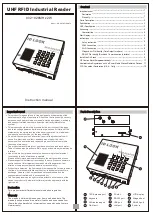
APCI-3xxx Appendix
55
Impedance
The reciprocal of admittance. Admittance is the complex ratio
of the voltage across divided by the current flowing through a
device, circuit element, or network.
Inductive loads
The voltage over the inductor is U=L.(dI/dt), whereas L is the
inductivity and I is the current. If the current is switched on fast,
the voltage over the load can become very highly for a short
time.
Input impedance
The measured resistance and capacitance between the high and
low inputs of a circuit.
Input level
The input level is the logarithmic relation of two electric units
of the same type (voltage, current or power) at the signal input
of any receive device. The receive device is often a logic level
that refers to the input of the switch. The input voltage that
corresponds with logic “0” is here between 0 and 15 V, and the
one that corresponds with logic “1” is between 17 and 30 V.
Interrupt
A signal to the CPU indicating that the board detected the
occurrence of a specified condition or event.
Level
Logic levels are defined in order to process or show
information. In binary circuits voltages are used for digital
units. Only two voltage ranges represent information. These
ranges are defined with H (High) and L (Low). H represents the
range that is closer to Plus infinite; the H level is the digital 1. L
represents the range that is closer to Minus infinite; the L level
is the digital 0. The rising edge is the transition from the 0-state
to the 1-state and the falling edge is the transition from the 1-
state to the 0-state.
Limit value
Exceeding the limit values, even for just a short time, can lead
to the destruction or to a loss of functionality.
MUX =
Multiplexer
An array of semiconductor or electromechanical switches with
a common output used for selecting one of a number of input
signals.
Noise immunity
Noise immunity is the ability of a device to work during an
electromagnetic interference without reduced functions.
Noise suppression
The suppression of undesirable electrical interferences to a
signal. Sources of noise include the ac power line, motors,
generators, transformers, fluorescent lights, CRT displays,
computers, electrical storms, welders, radio transmitters, and
others.
Operating voltage
The operating voltage is the voltage that occurs during the
continuous operation of the device. It may not exceed the
continuous limit voltage. Furthermore, any negative operation
situations, such as net overvoltages over one minute at
switching on the device must be taken in consideration.
Optical isolation
The technique of using an optoelectric transmitter and receiver
to transfer data without electrical continuity, to eliminate high-
potential differences and transients.
Output voltage
The nominal voltage output reading when shaft is rotated to full
range, expressed in volts DC /Vo DC).





































